
The Jamestown settlement in the Colony of Virginia was the first permanent English settlement in the Americas. It was located on the northeast bank of the James River, about 2.5 mi (4 km) southwest of the center of modern Williamsburg. It was established by the Virginia Company of London as "James Fort" on May 4, 1607 O.S., and was considered permanent after a brief abandonment in 1610. It followed several failed attempts, including the Lost Colony of Roanoke, established in 1585 on Roanoke Island, later part of North Carolina. Jamestown served as the colonial capital from 1616 until 1699. Despite the dispatch of more settlers and supplies, more than 80 percent of the colonists died in 1609–10, mostly from starvation and disease. In mid-1610, the survivors abandoned Jamestown, though they returned after meeting a resupply convoy in the James River.

Jamestown Settlement is a living history museum operated by the Commonwealth of Virginia, created in 1957 as Jamestown Festival Park for the 350th anniversary celebration. Today it includes a recreation of the original James Fort, a Powhatan Native American town, indoor and outdoor displays, and replicas of the original settlers' ships: the Susan Constant, Godspeed, and Discovery.

John Rolfe was an English explorer, farmer and merchant. He is best known for being the husband of Pocahontas and the first settler in the colony of Virginia to successfully cultivate a tobacco crop for export.

The Northern Neck is the northernmost of three peninsulas on the western shore of the Chesapeake Bay in the Commonwealth of Virginia. The Potomac River forms the northern boundary of the peninsula; the Rappahannock River demarcates it on the south. The Northern Neck encompasses the following Virginia counties: Lancaster, Northumberland, Richmond, King George and Westmoreland; it had a total population of 50,158 as of the 2020 census.
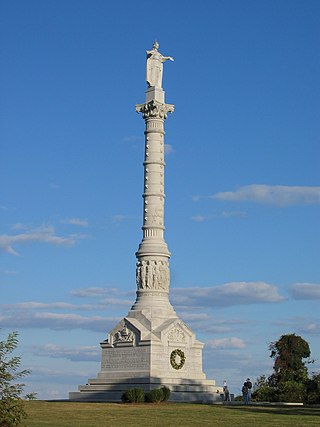
Colonial National Historical Park is a large national historical park located in the Hampton Roads region of Virginia operated by the National Park Service. It protects and interprets several sites relating to the Colony of Virginia and the history of the United States more broadly. These range from the site of the first English settlement at Jamestown, to the battlefields of Yorktown where the British Army was defeated in the American Revolutionary War. Over 3 million people visit the park each year.

The George Washington Birthplace National Monument is a national monument in Westmoreland County, Virginia, at the confluence of Popes Creek and the Potomac River. It commemorates the birthplace location of George Washington, a Founding Father and the first President of the United States, who was born here on February 22, 1732. Washington lived at the residence until age three and later returned to live there as a teenager.

Sterling, Virginia, refers most specifically to a census-designated place (CDP) in Loudoun County, Virginia, United States. The population of the CDP as of the 2010 United States Census was 27,822. The CDP boundaries are confined to a relatively small area between Virginia State Route 28 on the west and Virginia State Route 7 on the northeast, excluding areas near SR 606 and the Dulles Town Center.

The George Washington Memorial Parkway, colloquially the G.W. Parkway, is a 25-mile-long (40 km) parkway that runs along the south bank of the Potomac River from Mount Vernon, Virginia, northwest to McLean, Virginia, and is maintained by the National Park Service (NPS). It is located almost entirely within Virginia, except for a short portion of the parkway northwest of the Arlington Memorial Bridge that passes over Columbia Island within the District of Columbia.
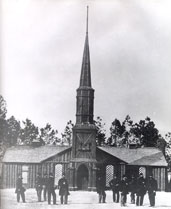
Poplar Grove National Cemetery is near Petersburg, Virginia, and is managed as part of Petersburg National Battlefield.

Established in 1994, the Cane River Creole National Historical Park serves to preserve the resources and cultural landscapes of the Cane River region in Natchitoches Parish, Louisiana. Located along the Cane River Lake, the park is approximately 63 acres and includes two French Creole cotton plantations, Oakland and Magnolia. Both plantations are complete in their historic settings, including landscapes, outbuildings, structures, furnishings, and artifacts; and they are the most intact French Creole cotton plantations in the United States. In total, 65 historic structures and over a million artifacts enhance the National Park Service mission as it strives to tell the story of the evolution of plantation agriculture through the perspective of the land owners, enslaved workers, overseers, skilled workers, and tenant farmers who resided along the Cane River for over two hundred years. This park is included as a site on the Louisiana African American Heritage Trail.
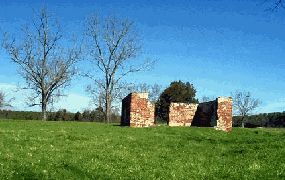
Green Spring Plantation in James City County about five miles (8.0 km) west of Williamsburg, was the 17th century plantation of one of the most unpopular governors of Colonial Virginia in North America, Sir William Berkeley, and his wife, Frances Culpeper Berkeley.
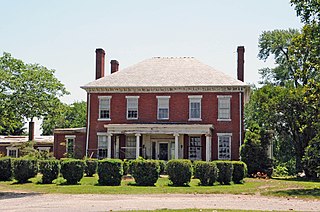
Varina Farms, also known as Varina Plantation or Varina Farms Plantation or Varina on the James, is a plantation established in the 17th century on the James River about 10 miles (16 km) south of Richmond, Virginia. An 820-acre (330 ha) property was listed on the National Register of Historic Places in 1977 as "Varina Plantation". At that time it included two contributing buildings and one other contributing site.

Green Springs National Historic Landmark District is a national historic district in Louisa County, Virginia noted for its concentration of fine rural manor houses and related buildings in an intact agricultural landscape. The district comprises 14,000 acres (5,700 ha) of fertile land, contrasting with the more typical poor soil and scrub pinelands surrounding it.

The Chesapeake Colonies were the Colony and Dominion of Virginia, later the Commonwealth of Virginia, and Province of Maryland, later Maryland, both colonies located in British America and centered on the Chesapeake Bay. Settlements of the Chesapeake region grew slowly due to diseases such as malaria. Most of these settlers were male immigrants from England who died soon after their arrival. Due to the majority of men, eligible women did not remain single for long. The native-born population eventually became immune to the Chesapeake diseases and these colonies were able to continue through all the hardships.
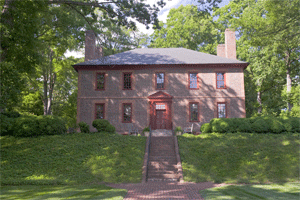
Wilton House Museum is a museum in a historic house located in Richmond, Virginia. Wilton was constructed c. 1753 by William Randolph III, son of William Randolph II, of Turkey Island. Wilton was originally the manor house on a 2,000-acre (8.1 km2) tobacco plantation known as "World's End" located on the north bank of the James River several miles east of the city of Richmond. Between 1747 and 1759, William III acquired more than a dozen contiguous tracts of land. About 1753, Randolph completed building a Georgian manor house, which he named "Wilton," on a site overlooking the river.
The George Tyler Moore Center for the Study of the Civil War, in Shepherdstown, West Virginia, is a Civil War research center at Shepherd University.
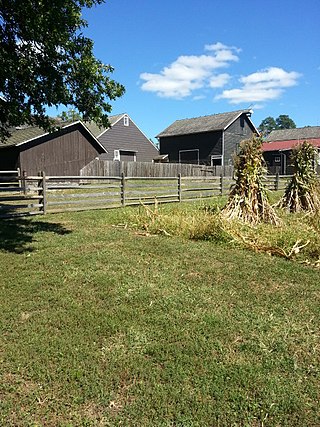
Historic Longstreet Farm is a living history farm in Holmdel, New Jersey. The farm is only 9 of 664 acres within Holmdel Park. In 2021, Holmdel Park received 1,096,379 visitors, while Longstreet Farm received 102,522 visitors. It is operated by the Monmouth County Park System. Today, the farm is a recreation of rural life in Monmouth County as it was the 1890s. Staff dresses in period clothing, while performing the daily and seasonal agricultural and domestic activities of a resident of the time period, such as planting and harvesting of crops, taking caring of the livestock, etc. Admission and parking are free.






















